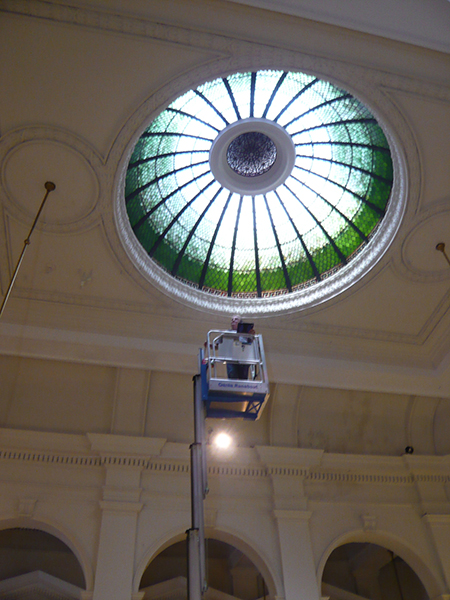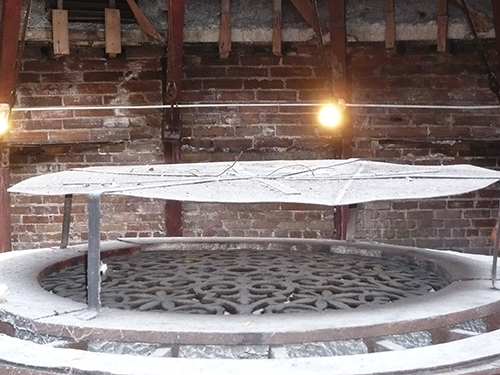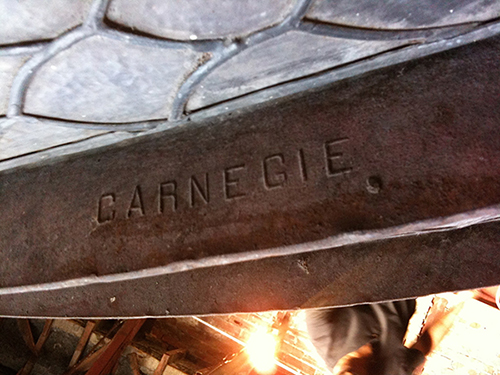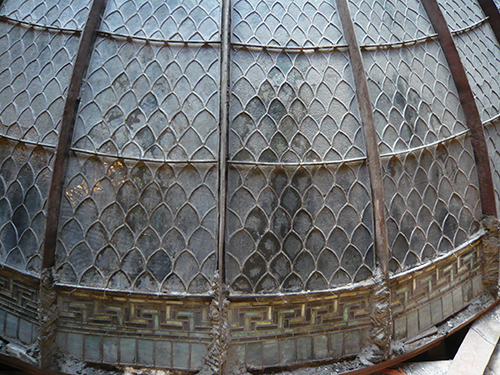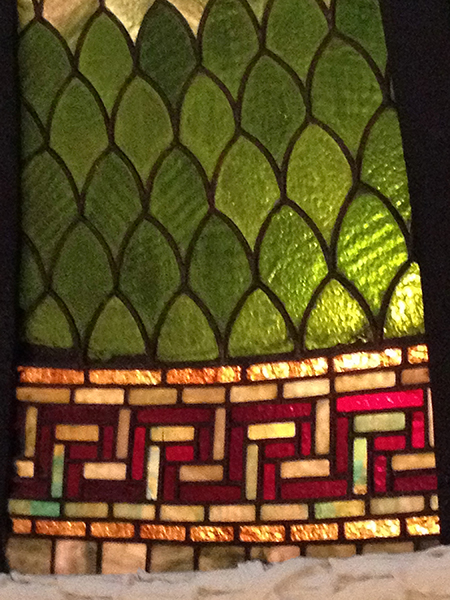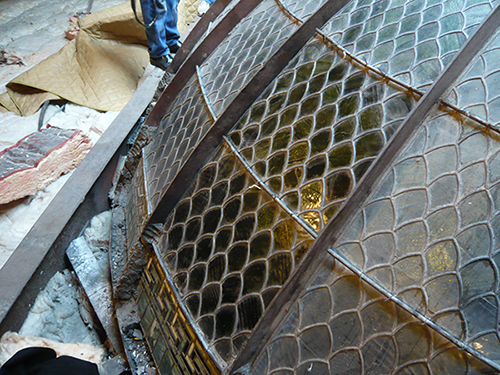In late August, I met with Gibbes staff members Zinnia Willits and Greg Jenkins, and Chris Botti from Botti Studio of Architectural Arts, Inc. to discuss the dome in the Rotunda Gallery on the second floor. Botti has worked on many ornate Beaux Art ceilings including the Tiffany Domes at the Chicago Cultural Center and at the Driehaus Museum in Chicago. First, we sat in the conference room to just talk about the 107-year history of the dome and the issues that we thought needed to be addressed. Then we walked out to the gallery and studied the ceiling, noting the various repairs that have occurred over the years. We discussed the very elaborate ceiling decorations, and imagined their earlier grandeur and ornate finishes, long since painted white.
Then it was time to climb the ladder from the second floor up to the old attic space. Getting into the area around the dome is like navigating a labyrinth in the stifling Charleston heat. We crawled through the very small hatch into the attic area above the second floor Main gallery. We walked across the ceiling, holding on to the steel pipes and cabling while we navigated from one steel support beam to the next to protect the very delicate and fragile plaster below. Finally, we squeezed through the last doorway into the Rotunda light attic. The light attic is a large space that is engineered to catch as much light as possible and focus it onto the surface of the dome—almost like a giant tanning parlor.
When we got up to the dome we walked around it balancing on the large steel beams that the dome rests upon. As we skirted the perimeter, Chris began to talk about how the dome was made and installed, and pointed out some of the areas in need of conservation. The arched steel “T” shaped beams that formed the bones of the dome were all stamped “Carnegie” which identified them as being made by the famous company in Pittsburg, Pennsylvania that supplied most of America’s steel at the beginning of the twentieth century. We have not found markings on the dome as of yet that identify it as being designed and manufactured by the studio of Louis Comfort Tiffany (1848 – 1933), but the Carnegie Foundation has kept very good records so we anticipate that we might be able to find out if the steel was ordered by Tiffany’s company. Chris said that we may find one of Tiffany’s famous lead tags stamped “Tiffany,” or the Tiffany name etched somewhere in the bottom right corner of one of the large triangular leaded glass panels.
To create the dome, each piece of stained glass was hand cut in the studio. Then, they were assembled into leaded glass panels resting on a large table and soldered into place. At that point, the panels were shipped to the museum. Upon arrival, the panels were laid into triangular spaces between the steel beam supports and secured with solder or wooden shims. Lead cross bars were wired onto the back of each of the panels to prevent the heavy pieces from collapsing due to gravity. Installers carefully aligned the bars, so that the bracings would then line up when viewed from the floor level below.
As we reviewed each of the panels we identified cracks and points of minor damage that had occurred during installation and over the years. Overall, Chris was not worried about the security of the dome, and suggested that it should stay in place rather than being taken down for repairs. We concluded that one of the most important safety repairs we could make would be to install safety railings and walkways around the entire dome area.
The final prognosis for the entire dome was that it simply needed a complete cleaning and certification that the leading and bracings were all secure. The glass is covered with a thick layer of dust, but one section which we wiped clean with damp cloths showed just how much crisper and brighter the stained glass will be once it has been professionally cleaned. Special solutions will be used that are specifically made for cleaning stained glass without harming the glass or leaving any film residue. As a funny aside, Chris said that some people actually clean the stained glass with horse shampoo because it has the right consistency and delicacy for gently getting the grime off the stained glass windows!
Once the entire dome has been cleaned we will all look very carefully for any signature or a lead stamp to certify that the dome was made by the Tiffany studios. We will continue to do further research with the Carnegie archives and consult with Tiffany scholars for additional clues. Our hope is that before we re-open the renovated museum to the public, our investigation will reveal the undeniable proof of Tiffany’s craftsmanship. But regardless of its provenance, the Rotunda Dome will remain a major showpiece for the museum that will sparkle much brighter with a little TLC.
—Jeff Daly, museum designer and guest blogger
Published November 19, 2012


